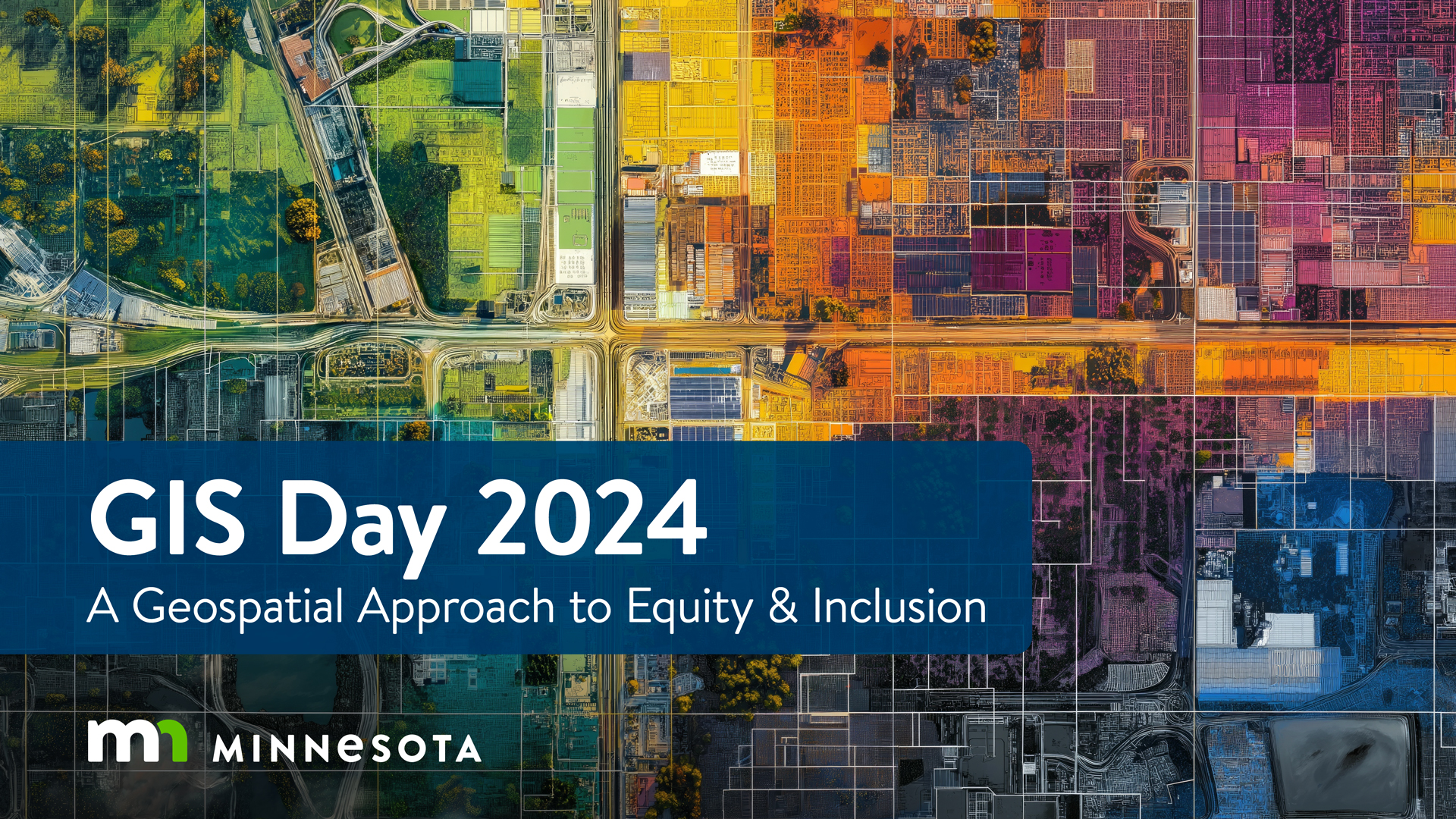GIS Day 2024 - A Geospatial Approach to Equity & Inclusion
 This event was held on November 21, 2024, to celebrate GIS Day and explore how a geospatial approach can promote equity and inclusion. Everyone was welcome to this event hosted by
Minnesotaís State Agency GIS Collaborative!
This event was held on November 21, 2024, to celebrate GIS Day and explore how a geospatial approach can promote equity and inclusion. Everyone was welcome to this event hosted by
Minnesotaís State Agency GIS Collaborative!
Check out the event's equity and inclusion GIS resources handout.
Event Overview
- Who: GIS professionals, state employees, equity leaders, community advocates
- What: Presentations, panel discussions, networking, and more
- When: 8 a.m. - 3 p.m. on Thursday, November 21, 2024
- Where: Room 2000, Stassen Building, 600 N Robert Street, Saint Paul, MN 55146 - or - Microsoft Teams (available for morning sessions only)
Agency program managers, equity practitioners, and GIS professionals shared their experiences using geographic information systems (GIS) to address equity in designing and delivering State of Minnesota
services. Attendees received valuable insights and resources for applying GIS within their organizations. While the focus was on state programs, the information shared has
tangible applications to other levels of government, non-profits, education, and the private sector.
The morning sessions were available in a hybrid format, allowing attendance via Microsoft Teams or in person. The afternoon sessions were in-person only:
after a provided lunch, a moderated panel session featured morning speakers discussing the challenges and successes in reaching equitable program goals through
geospatial analysis. The day concluded with informal consultations with GIS professionals for those interested in exploring how GIS can benefit their programs.
See the full agenda below. For event questions, please reach out to gisinfo.mngeo@state.mn.us.
Event Registration
Event registration closed on November 15, 2024.
Agenda
Presentation description and speaker information can be found after the agenda below.
| Time | Activity |
| 8:00 a.m. - 8:30 a.m. | Coffee Meet Ďn Greet |
| 8:30 a.m. - 8:45 a.m. | Welcome Message
Minnesota Governorís Office of Equity, Opportunity, and Accessibility |
| 8:45 a.m. - 9:30 a.m. | A Journey from Legislation to Spatial Data in Implementing Environmental Justice
Minnesota Pollution Control Agency | Minnesota IT Services |
| 9:30 a.m. - 10:15 a.m. | Understanding Geographic and Sociodemographic Disparities in adhering to Early Hearing Detection and Intervention Benchmarks
Minnesota Department of Health |
| 10:15 a.m. - 10:30 a.m. | Break |
| 10:30 a.m. - 11:15 a.m. | Child Care Access Equity Areas: A New Way to Prioritize Child Care Access Support
Department of Children, Youth, and Families |
| 11:15 a.m. - 12:00 p.m. | Equity and Innovation: Using GIS Tools to Advance Safe Routes to School in Minnesota
Minnesota Department of Transportation |
| 12:00 p.m. - 1:00 p.m. | Lunch (provided) |
| 1:00 p.m. - 2:00 p.m. | Panel Session on GIS as a Tool for Equity & Inclusion
Morning Presenters | Moderated by Minnesota's Chief Geospatial Information Officer, Alison Slaats |
| 2:00 p.m. - 3:00 p.m. | Ask an Expert (open consult) |

Following the agenda activities, event sponsor, the Minnesota GIS/LIS Consortium,
continued the celebration of GIS with a nearby networking social.
The networking event was open to the public and provided additional opportunity
for connecting with the day's attendees and other geospatial professionals and enthusiasts from the community. Giveaways, game prizes, and other
opportunities to snag some GIS Day swag were available!
Minnesota GIS/LIS Consortium GIS Day Celebration
Thursday, November 21, 2024
3:30 p.m. - 6:30 p.m.
Summit Brewing Ė Saga Room
910 Montreal Cir, Saint Paul, MN 55102
Presentation Descriptions
Welcome Message
Opening remarks from the Governorís Office of Equity, Opportunity, and Accessibility.
Ashley Oolman, Interim Chief Equity Officer, Office of Equity, Opportunity, and Accessibility within the
Minnesota Governorís Office | Director of Equity and Inclusion, Minnesota Department of Human Services
A Journey from Legislation to Spatial Data in Implementing Environmental Justice
See how the Minnesota Pollution Control Agency and Minnesota IT Services took criteria established by the 2023 legislature and turned it into mapped information used to
determine agency-wide decisions. From text to polygons, MPCA used this new geospatial data Ė Environmental Justice Areas Ė to integrate environmental
justice into its work by providing easy-access information to its employees and the public on areas of lower income, communities of color, limited English language proficiency,
and tribal lands. This approach is empowering data-driven decisions, safeguarding at-risk communities from disproportionate pollution burdens, and facilitating
increased community engagement.
Ned Brooks, Environmental Justice Coordinator, Minnesota Pollution Control Agency
Amanda Gorton, PhD, Data Analysis Supervisor, Minnesota Pollution Control Agency
Jason Ewert, GIS Application Analyst, Minnesota IT Services partnering with Minnesota Pollution Control Agency
Understanding Geographic and Sociodemographic Disparities in adhering to Early Hearing Detection and Intervention Benchmarks
Congenital hearing loss is a common chronic condition in children and facilitating early intervention is crucial to limit the negative impacts of permanent hearing loss. Early Hearing Detection and Intervention programs currently in place suggest screening all infants for hearing loss by 1 month of age, and those who do not pass and are referred directly to audiology to receive a diagnostic evaluation by 3 months of age. However, not all infants are screened by 1 month or, if needed, get diagnosed by 3 months of age for a wide range of reasons that havenít been thoroughly studied in Minnesota. Variables such as drive time to the clinic or parentís sociodemographic backgrounds are hypothesized to influence the parentís interested or ability to meet the screening benchmarks. This study considered which variables might be most important for meeting the benchmarks and identified an optimal model that might help predict benchmark compliance.
Anton Kvit, Data Scientist, Minnesota Department of Health Office of Data Strategy and Interoperability
Amanda Pavan, Senior Epidemiologist, Minnesota Department of Health Division of Public Health Laboratory
Child Care Access Equity Areas: A New Way to Prioritize Child Care Provider Supports
Minnesota was one of the first states in the nation to invest state dollars in direct compensation supports for child care programs through
the Great Start Compensation Support Payment Program. In developing this innovative program, the Child Care Services (CCS) team wanted to build
in a mechanism for boosting investment in communities facing multiple barriers to accessing high-quality child care. Part of the solution was
developing Child Care Access Equity Areas, geographic areas statewide where communities are facing greater challenges related to income, housing,
employment, and child care access, and where child care programs are eligible for a 10% increase to their Great Start Compensation payments. Since their
inception as part of this specific program, the Access Equity Areas have found multiple other uses as well, within CCS and beyond.
Angela Butel, Data and Policy Analyst, Minnesota Department of Children, Youth, and Families
Equity and Innovation: Using GIS Tools to Advance Safe Routes to School in Minnesota
Presenters showcased how the Student Transportation Equity for Priority Populations
(STEPP) and Visualizing Safe Routes to School tools use GIS technology to drive equitable funding decisions,
foster innovation, and promote community engagement within the Minnesota Department of Transportationís (MnDOT) Safe Routes to
School (SRTS) program. The STEPP tool assigns objective equity scores to guide grant prioritization, ensuring resources reach high-need communities, while the Visualizing
Safe Routes to School tool maps the distribution of millions in statewide investments and helps MnDOT district staff easily find SRTS plans when scoping projects. Together,
these tools provide actionable insights that align with strategic goals, advance fairness in resource allocation, and strengthen connections with communities to create safer,
more accessible active transportation options to support youth walking, biking, and rolling to and from school or other destinations they want or need to go to.
Kelly Corbin, Safe Routes to School Coordinator, Minnesota Department of Transportation Office of Transit and Active Transportation
Sophie Kalow, Safe Routes to School Planner, Minnesota Department of Transportation Office of Transit and Active Transportation
Panel Session on GIS as a Tool for Equity & Inclusion
Morning presenters came together with attendees to discuss the transformative role of GIS in fostering equity and inclusion across state services. Led by Minnesota's Chief
Geospatial Information Officer, Alison Slaats, the discussion highlighted the challenges, successes, and limitations of using a geospatial approach to support program initiatives.
Moderator: Alison Slaats, Chief Geospatial Information Officer, State of Minnesota | Director, Minnesota IT Services Geospatial Information Office
Panelists: Morning presenters, including Ashley Oolman, Angela Butel, Anton Kvit, Jason Ewert, Kelly Corbin, Ned Brooks, and Sophie Kalow

